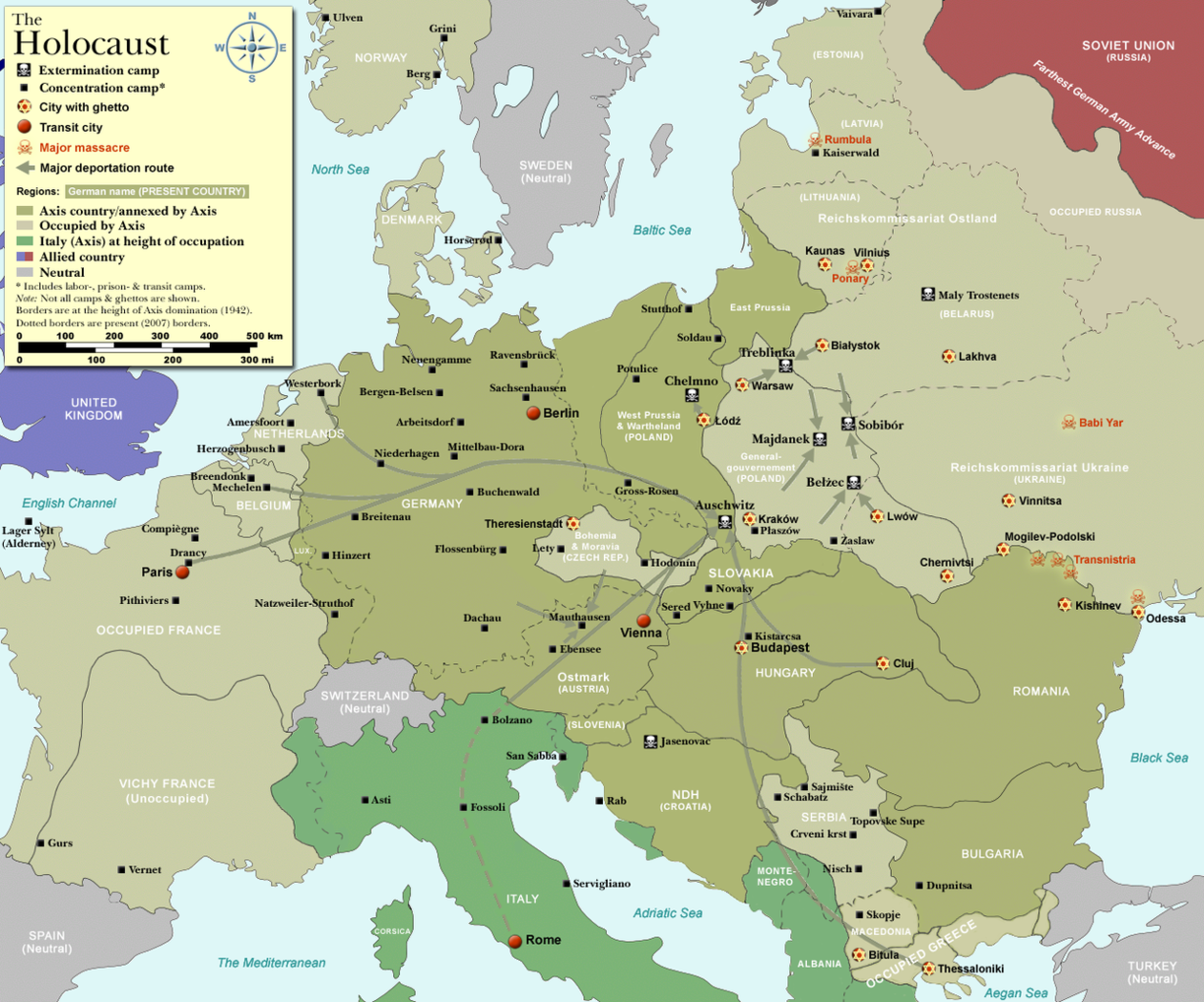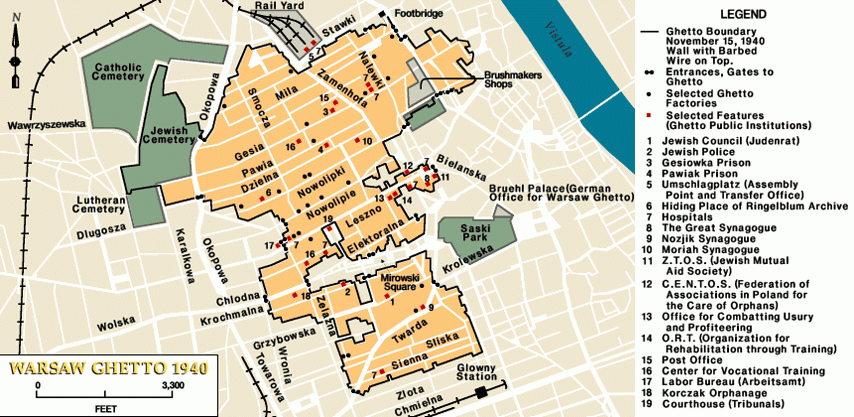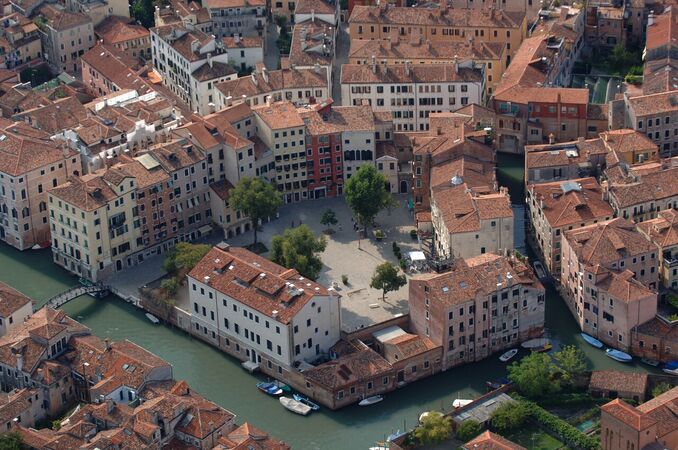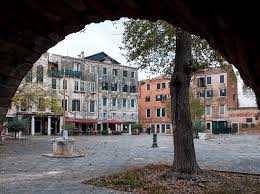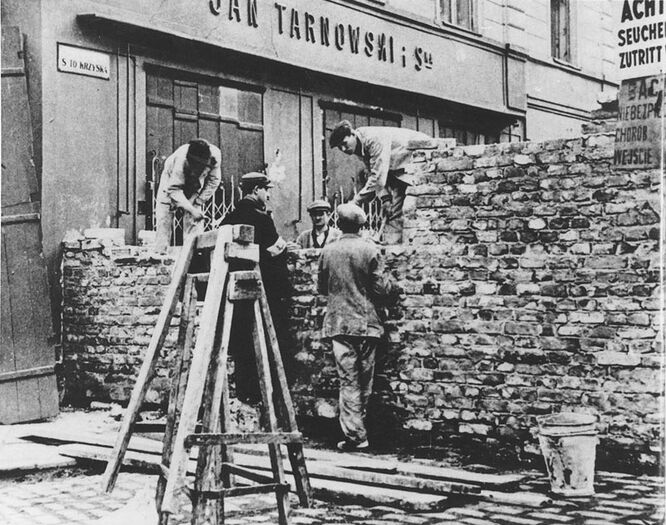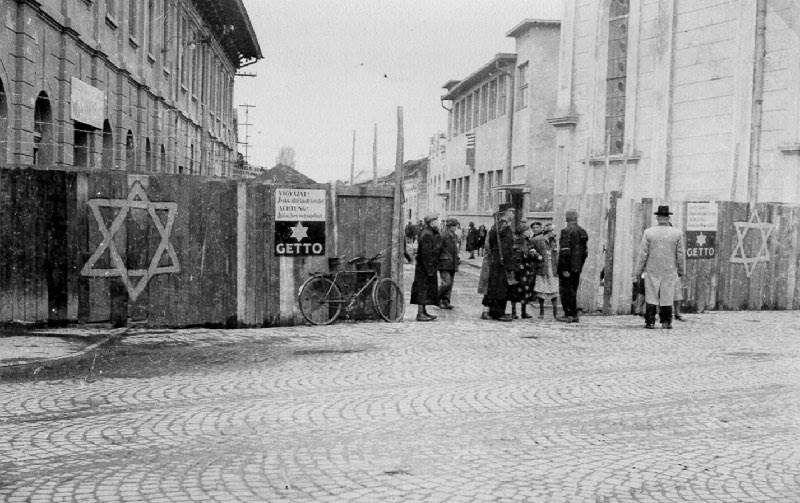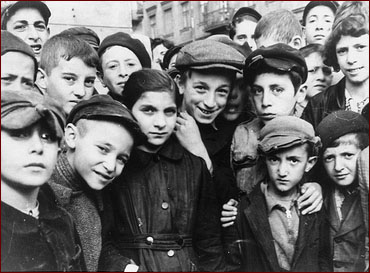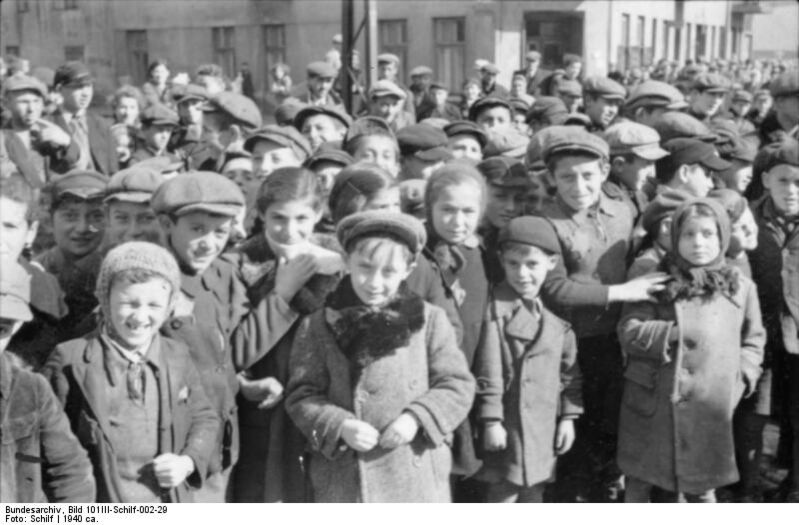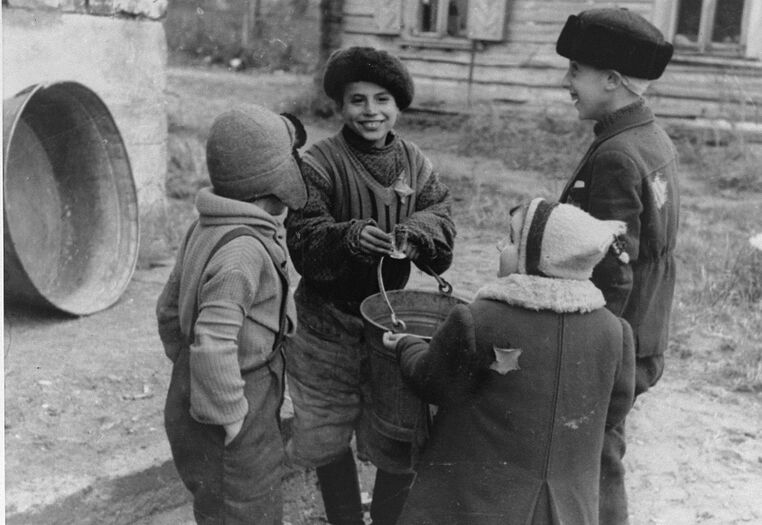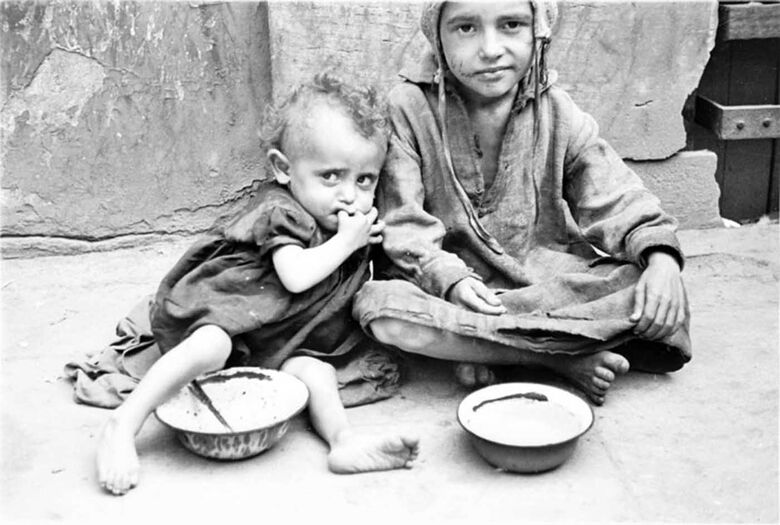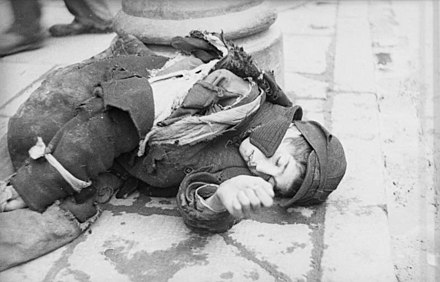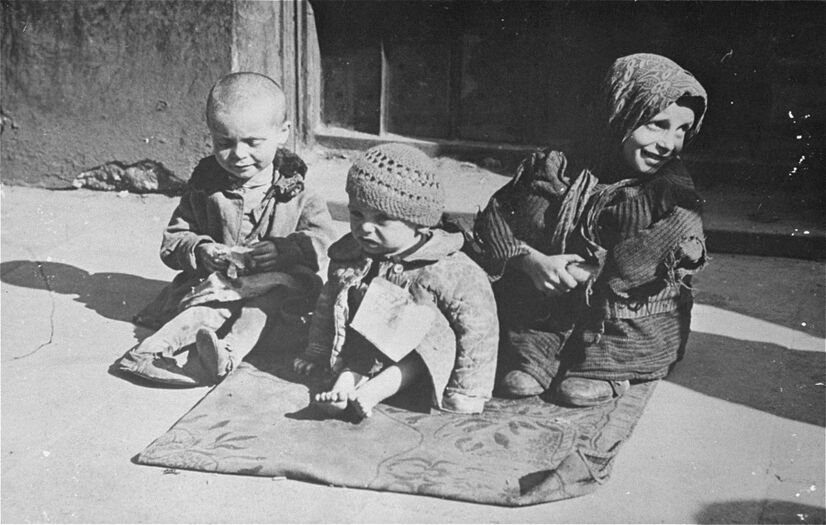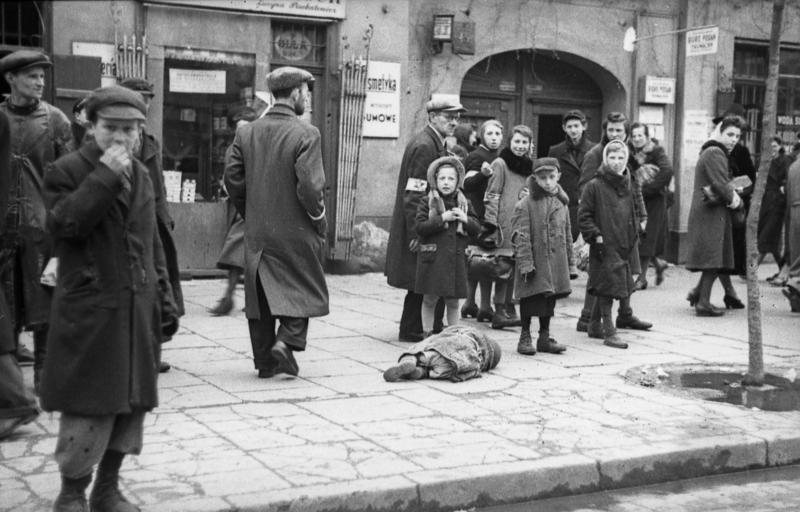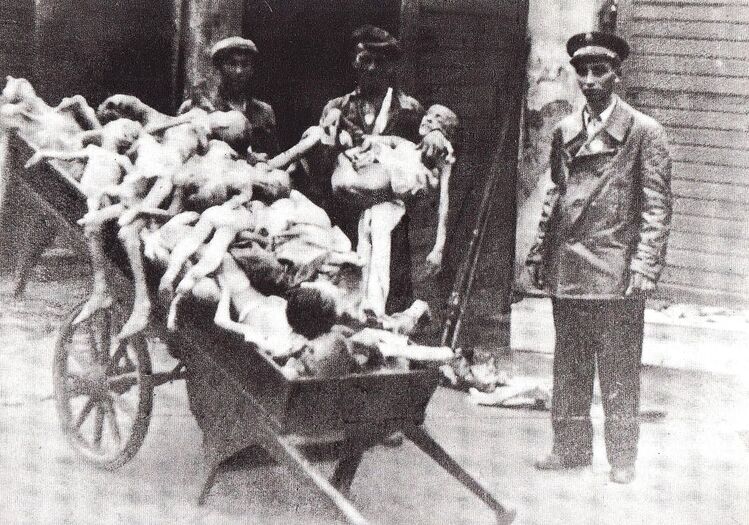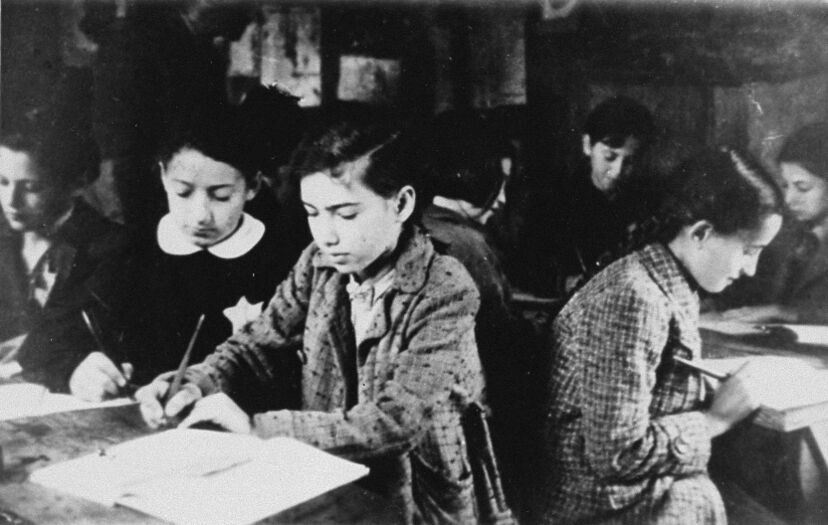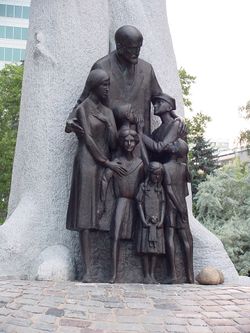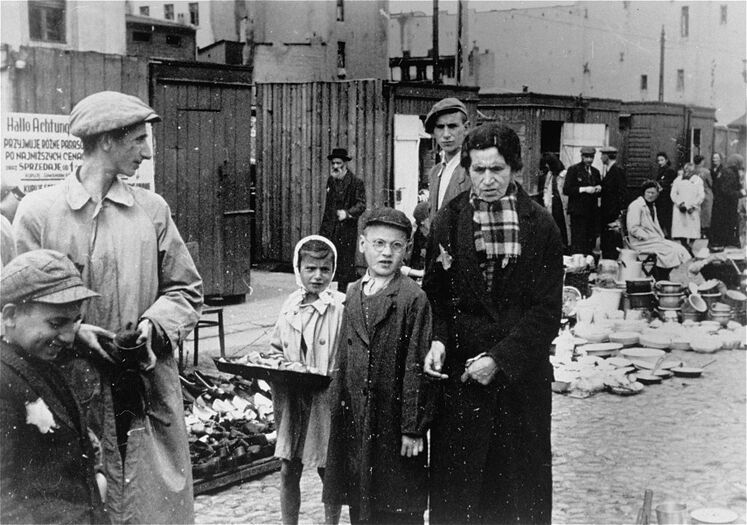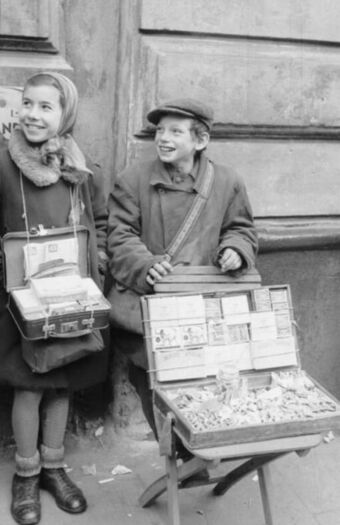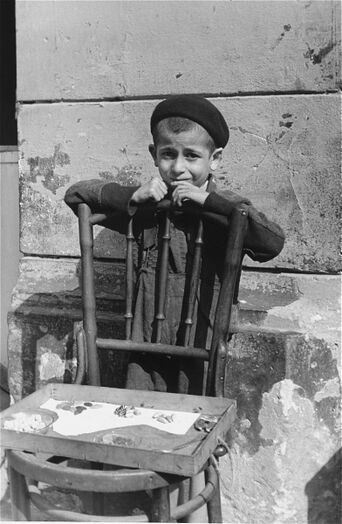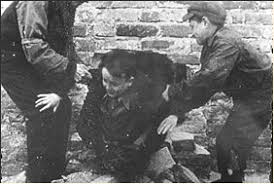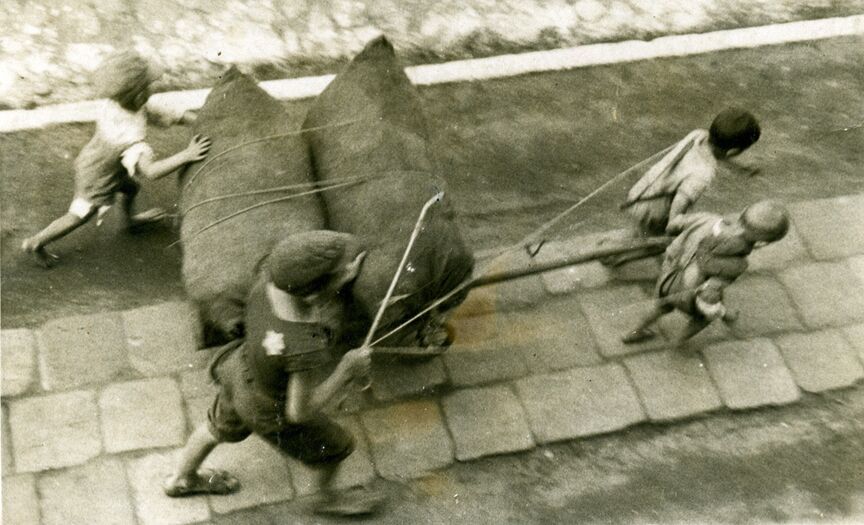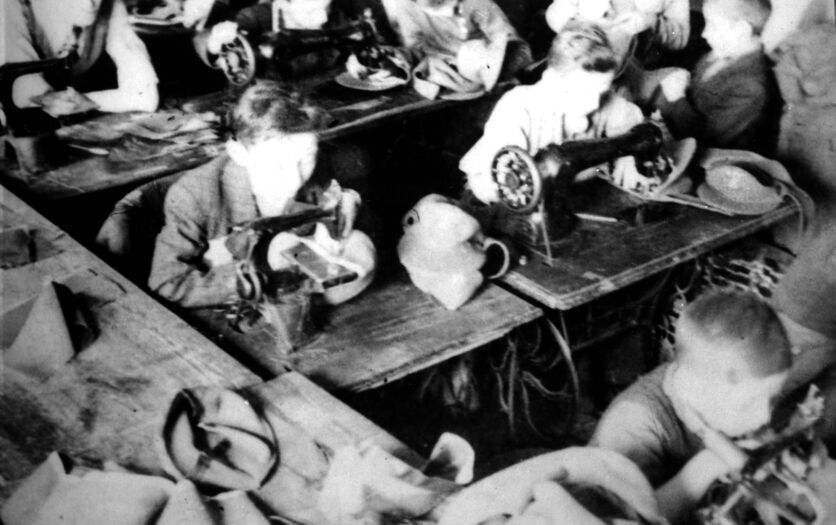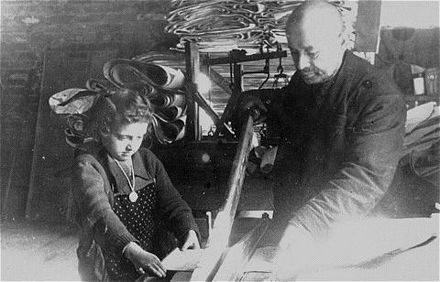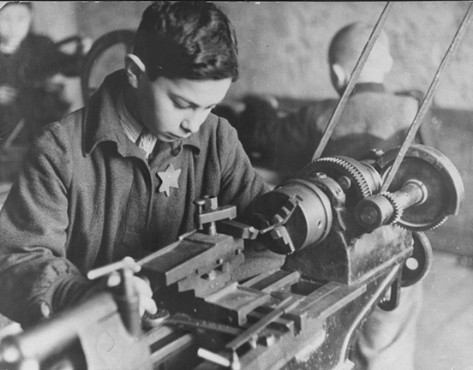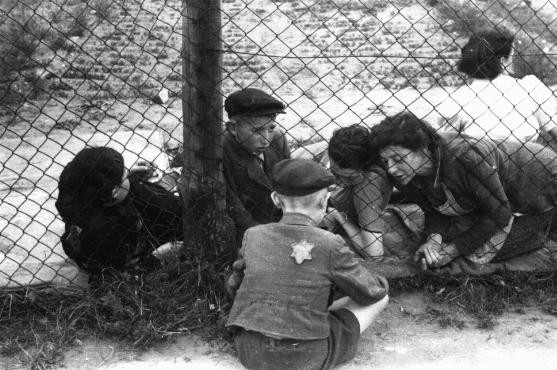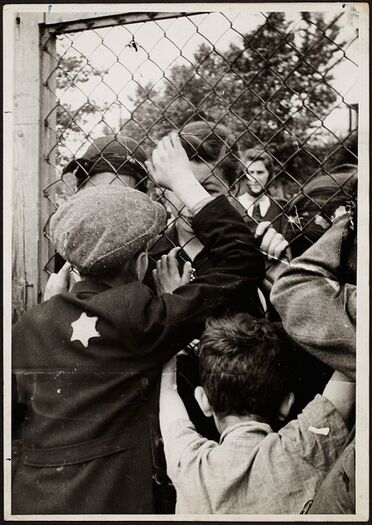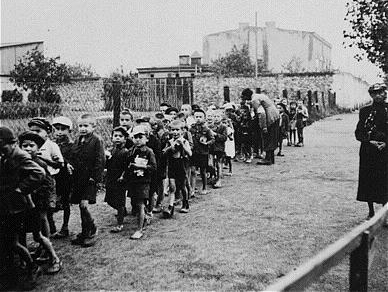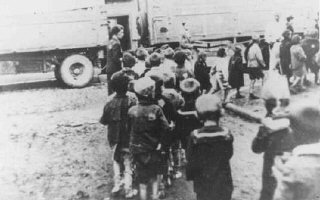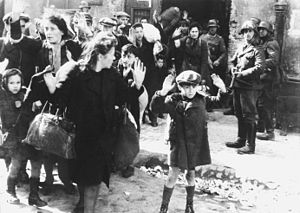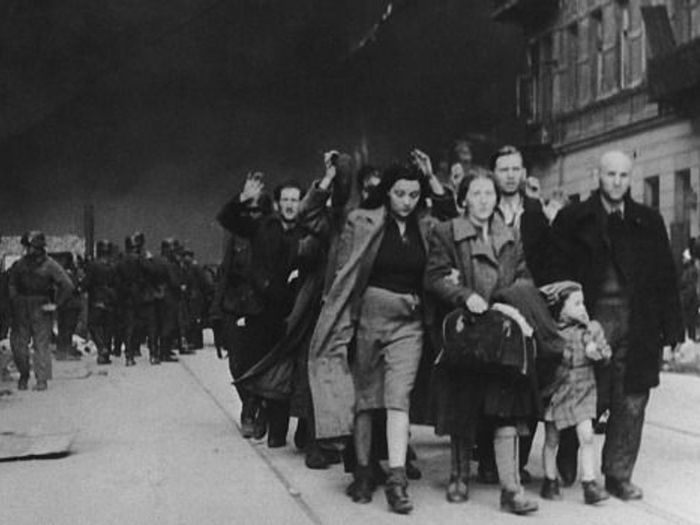Difference between revisions of "Nazi Ghettos"
| (58 intermediate revisions by the same user not shown) | |||
| Line 1: | Line 1: | ||
[[File:Nazi Ghettos.png | '''Nazi Ghettos''' (see [[Holocaust Children Studies]]) | ||
* [[Nazi Ghettos]] -- [[Internment Camps]] -- [[Transit Camps]] -- [[Concentration Camps]] -- [[Mass Shootings]] -- [[Death Camps]] | |||
<gallery mode=packed align=left heights=700> | |||
File:Nazi Ghettos.png | |||
File:Warsaw Ghetto Map.gif | |||
</gallery> | |||
| Line 6: | Line 14: | ||
Hundreds of ghettos were established. In most cases they functioned only as a temporary concentration of the local Jewish population before moving them to the major urban ghettos or directly to killing centers (designed areas in the woods or death camps). The major ghettos were those in Warsaw (500.000 people), Lodz, Krakow, Lvov, Bialystok, Lakhva in Poland; Kaunas and Vilnius in Lithuania; Budapest and Cluj in Hungary; Theresienstadt in Czechia. | Hundreds of ghettos were established. In most cases they functioned only as a temporary concentration of the local Jewish population before moving them to the major urban ghettos or directly to killing centers (designed areas in the woods or death camps). The major ghettos were those in Warsaw (500.000 people), Lodz, Krakow, Lvov, Bialystok, Lakhva in Poland; Kaunas and Vilnius in Lithuania; Budapest and Cluj in Hungary; Theresienstadt in Czechia. | ||
==The ancient | ==The ancient ghettos and the new ghettos== | ||
Jews in Europe had lived in Ghettos for many centuries, from the 16th century until the emancipation (19th century). The ghettos were quarters (often surrounded by walls) where Jews were confined. Gates were closed at night, but during the day the ghetto was open for business with little restrictions. Jews were free to mingle with the rest of the population during the day for trade and business. They were free to stay or to leave or to travel. Their properties were protected. | |||
<gallery mode=packed align=left heights=300> | |||
File:Venice Ghetto.jpg | |||
File:Venice Ghetto2.jpg | |||
</gallery> | |||
Nazi ghettos took the same name but were something different. They were prisons surrounded by walls, patrolled by armed guards, where the local Jewish population was forced to live, after being deprived of all their belongings. Jews could leave the area only under escort. They were subjected to forced labor. | |||
<gallery mode=packed align=left heights=350> | |||
File:Warsaw Ghetto.jpg | |||
File:Warsaw Ghetto2.jpg | |||
</gallery> | |||
Living conditions in the ghettos, however, were brutal. Any hopes for a "normal" life quickly disappeared. Ghettoes were overcrowded. Hygiene conditions were disastrous. There was little heating during the winters. The Jews were not allowed out of the ghetto, so they had to rely on smuggling and the starvation rations supplied by the Nazis: in Warsaw this was 253 calories (1,060 kJ) per Jew, compared to 669 calories (2,800 kJ) per Pole and 2,613 calories (10,940 kJ) per German (the minimum recommended for an healthy life is 1,200). With the crowded living conditions, starvation diets, and insufficient sanitation (coupled with lack of medical supplies), epidemics of infectious disease became a major feature of ghetto life. before July 1942, 20% of residents died of 'natural' causes: some 43,800 in the Łódź Ghetto, 76,000 in the Warsaw Ghetto ... | |||
==Living conditions (Segregation, Starvation, Exploitation, Death) == | |||
Initially the ghettos were given some appearance of self-government under a Jewish Council (Judenrat) and a Jewish Ghetto police. Schools, hospitals and orphanages were organized for children. The streets of the ghettos were full of children (in Warsaw [1], Lodz [2], Kovno [3], etc.): | |||
<gallery mode=packed align=left heights=350> | |||
File:Warsaw children5.jpg | |||
File:Lodz children5.jpg | |||
File:Kovno children3.jpg | |||
</gallery> | |||
Living conditions in the ghettos, however, were brutal. Any hopes for a "normal" life quickly disappeared. Ghettoes were overcrowded. Hygiene conditions were disastrous. There was little heating during the winters. The Jews were not allowed out of the ghetto, so they had to rely on smuggling and the starvation rations supplied by the Nazis: in Warsaw this was 253 calories (1,060 kJ) per Jew, compared to 669 calories (2,800 kJ) per Pole and 2,613 calories (10,940 kJ) per German (the minimum recommended for an healthy life is 1,200). With the crowded living conditions, starvation diets, and insufficient sanitation (coupled with lack of medical supplies), epidemics of infectious disease became a major feature of ghetto life. before July 1942, 20% of residents died of 'natural' causes: some 43,800 in the Łódź Ghetto, 76,000 in the Warsaw Ghetto ... Additional food, clothing and medicine were available only on the black market. | |||
The children and the elderly were the ones who suffered mostly from the brutal living conditions in the ghetto. Children died from starvation and diseases as well as lack of adequate clothing and shelter. Soon the street of the ghettos were full of begging children. | The children and the elderly were the ones who suffered mostly from the brutal living conditions in the ghetto. Children died from starvation and diseases as well as lack of adequate clothing and shelter. Soon the street of the ghettos were full of begging children. | ||
<gallery mode=packed align=left heights=350> | |||
File:Warsaw children3.jpg | |||
File:Warsaw children8.jpg | |||
File:Warsaw children4.jpg | |||
File:Warsaw children9.jpg | |||
File:Warsaw children10.jpg | |||
</gallery> | |||
== Adult Resistance (Clandestine Schools, Orphanages) == | |||
The Jewish authorities in the ghettos organized schools for children, but soon educational instruction was formally banned. Limited elementary education continued clandestinely in private homes. German authorities permitted the continuation of vocational schools for teenagers. | |||
== | <gallery mode=packed align=left heights=350> | ||
File:Kovno Children2.jpg | |||
</gallery> | |||
==== The orphans of Warsaw ==== | ==== The orphans of Warsaw ==== | ||
[[File:Janusz Korczak.jpg|thumb|250px]] | [[File:Janusz Korczak.jpg|thumb|250px]] | ||
* See [https://www.youtube.com/watch?v=zGwnMgEx6b8 Janusz Korczak - Short Biography] (YouTube) (5m) | |||
In Warsaw the director of the orphanage, dott. Janusz Korczak (one of the most famous pedagogues of the 20th century), refused to abandon the children and marched with them to the train to Treblinka. No one survived. | In Warsaw the director of the orphanage, dott. Janusz Korczak (one of the most famous pedagogues of the 20th century), refused to abandon the children and marched with them to the train to Treblinka. No one survived. | ||
| Line 54: | Line 81: | ||
:''Dr. Janusz Korczak's children's home is empty now. A few days ago we all stood at the window and watched the Germans surround the houses. Rows of children, holding each other by their little hands, began to walk out of the doorway. There were tiny tots of two or three years among them, while the oldest ones were perhaps thirteen. Each child carried the little bundle in his hand.'' (Mary Berg) | :''Dr. Janusz Korczak's children's home is empty now. A few days ago we all stood at the window and watched the Germans surround the houses. Rows of children, holding each other by their little hands, began to walk out of the doorway. There were tiny tots of two or three years among them, while the oldest ones were perhaps thirteen. Each child carried the little bundle in his hand.'' (Mary Berg) | ||
== Children Resistance == | |||
In spite of their acute vulnerability, children discovered ways to survive. They worked either in labor brigades or at home caring for younger siblings and keeping house, selling goods, smuggling, pickpocketing, ecc. | |||
==== Vendors ==== | |||
<gallery mode=packed align=left heights=350> | |||
File:Ghetto Child Vendors3.jpg | |||
File:Ghetto Child Vendors1.jpg | |||
File:Ghetto Child Vendors2.jpg | |||
File:Ghetto Child Vendors4.jpg | |||
</gallery> | |||
==== Smugglers ==== | |||
Children smuggled food and medicine into the ghettos, in turn smuggling out their own personal possessions to trade for said goods. | |||
<gallery mode=packed align=left heights=350> | |||
File:Warsaw children.jpg | |||
File:Warsaw children2.jpg | |||
</gallery> | |||
==== Labor ==== | |||
In order to avoid deportation of the unemployed, many children tried to enroll as forced labor, as long as 12 hours a day. | |||
<gallery mode=packed align=left heights=350> | |||
File:Lodz children3.jpg | |||
File:Lodz children4.jpg | |||
File:Lodz children6.jpg | |||
File:Kovno children1.jpg | |||
</gallery> | |||
[[File:Lodz children6.jpg]] | |||
== A Special Ghetto: Theresienstadt == | |||
* See [https://www.youtube.com/watch?v=st4INYATIqc Hans Krása: Brundibár - children's opera] (YouTube, 10m) | |||
* See [[https://www.youtube.com/watch?v=E_cpvkIU6IY I'm Still Here Holocaust Survivor Diaries] (YouTube, 50m) | |||
==The killing == | |||
Starting from the end of 1941, the Nazis implemented the "final solution"--the extermination of the entire Jewish population of Europe. They did it first through mass shootings in the East, then with the establishment of death camps--Chelmno (Lodz), Treblinka (Warsaw and Bialystok), Sobibor, Belzec (Lvov), Majdanek, Auschwitz. The children and the elderly were the first to be eliminated. Orphanages and child hospitals in the ghettos were the first to be closed and all the residents killed or sent to extermination. | |||
==== The children of the Lodz Ghetto ==== | ==== The children of the Lodz Ghetto ==== | ||
| Line 63: | Line 138: | ||
Around 13.000 children were sent to die. No one survived. | Around 13.000 children were sent to die. No one survived. | ||
====The | <gallery mode=packed align=left heights=350> | ||
File:Lodz Children.jpg | |||
File:Lodz Children4.jpg | |||
File:Bambini Lodz3.jpg | |||
File:Lodz Children2.jpg | |||
</gallery> | |||
== The liquidation of the ghettos == | |||
In the end, all ghettos were liquidated. Their inhabitants were deported to concentration camps where the majority of them were killed in the gas chambers or used as labor force. Some ghettos (like the Warsaw Ghetto in 1943) heroically resisted Nazi Germany's final effort to transport the remaining population to death camps and were totally destroyed. | |||
Children were generally deported with the adults. Only an handful of children survived. Some children escaped the ghettos to join underground resistance activities such as Soviet partisan units; and lived as street children or in hiding, hosted to non-Jewish families. | |||
<gallery mode=packed align=left heights=350> | |||
File:Warsaw children6.jpg | |||
File:Warsaw children7.jpg | |||
</gallery> | |||
====The children of Bialystok ==== | |||
At the liquidation of the Bialystok Ghetto, on August 17, 1943, all the 1200 surviving children were separated form their families and sent by train to Theresienstadt. There were rumors that they would be exchanged with German P.O.W. The negotiation did not succeed and after a few weeks, all children were sent to die at Auschwitz. They were all killed at their arrival. No one survived. | |||
== The destruction of the Ghetto == | == The destruction of the Ghetto == | ||
Latest revision as of 11:06, 9 March 2023
Nazi Ghettos (see Holocaust Children Studies)
- Nazi Ghettos -- Internment Camps -- Transit Camps -- Concentration Camps -- Mass Shootings -- Death Camps
Soon after the 1939 German invasion of Poland, the Nazis began to force Jews to live in designate areas, or ghettos.
Hundreds of ghettos were established. In most cases they functioned only as a temporary concentration of the local Jewish population before moving them to the major urban ghettos or directly to killing centers (designed areas in the woods or death camps). The major ghettos were those in Warsaw (500.000 people), Lodz, Krakow, Lvov, Bialystok, Lakhva in Poland; Kaunas and Vilnius in Lithuania; Budapest and Cluj in Hungary; Theresienstadt in Czechia.
The ancient ghettos and the new ghettos
Jews in Europe had lived in Ghettos for many centuries, from the 16th century until the emancipation (19th century). The ghettos were quarters (often surrounded by walls) where Jews were confined. Gates were closed at night, but during the day the ghetto was open for business with little restrictions. Jews were free to mingle with the rest of the population during the day for trade and business. They were free to stay or to leave or to travel. Their properties were protected.
Nazi ghettos took the same name but were something different. They were prisons surrounded by walls, patrolled by armed guards, where the local Jewish population was forced to live, after being deprived of all their belongings. Jews could leave the area only under escort. They were subjected to forced labor.
Living conditions (Segregation, Starvation, Exploitation, Death)
Initially the ghettos were given some appearance of self-government under a Jewish Council (Judenrat) and a Jewish Ghetto police. Schools, hospitals and orphanages were organized for children. The streets of the ghettos were full of children (in Warsaw [1], Lodz [2], Kovno [3], etc.):
Living conditions in the ghettos, however, were brutal. Any hopes for a "normal" life quickly disappeared. Ghettoes were overcrowded. Hygiene conditions were disastrous. There was little heating during the winters. The Jews were not allowed out of the ghetto, so they had to rely on smuggling and the starvation rations supplied by the Nazis: in Warsaw this was 253 calories (1,060 kJ) per Jew, compared to 669 calories (2,800 kJ) per Pole and 2,613 calories (10,940 kJ) per German (the minimum recommended for an healthy life is 1,200). With the crowded living conditions, starvation diets, and insufficient sanitation (coupled with lack of medical supplies), epidemics of infectious disease became a major feature of ghetto life. before July 1942, 20% of residents died of 'natural' causes: some 43,800 in the Łódź Ghetto, 76,000 in the Warsaw Ghetto ... Additional food, clothing and medicine were available only on the black market.
The children and the elderly were the ones who suffered mostly from the brutal living conditions in the ghetto. Children died from starvation and diseases as well as lack of adequate clothing and shelter. Soon the street of the ghettos were full of begging children.
Adult Resistance (Clandestine Schools, Orphanages)
The Jewish authorities in the ghettos organized schools for children, but soon educational instruction was formally banned. Limited elementary education continued clandestinely in private homes. German authorities permitted the continuation of vocational schools for teenagers.
The orphans of Warsaw
- See Janusz Korczak - Short Biography (YouTube) (5m)
In Warsaw the director of the orphanage, dott. Janusz Korczak (one of the most famous pedagogues of the 20th century), refused to abandon the children and marched with them to the train to Treblinka. No one survived.
- Janusz Korczak was marching, his head bent forward, holding the hand of a child, without a hat, a leather belt around his waist, and wearing high boots. A few nurses were followed by two hundred children, dressed in clean and meticulously cared for clothes, as they were being carried to the altar. (Ghetto eyewitness, Joshua Perle)
- He told the orphans they were going out into the country, so they ought to be cheerful. At last they would be able to exchange the horrible suffocating city walls for meadows of flowers, streams where they could bathe, woods full of berries and mushrooms. He told them to wear their best clothes, and so they came out into the yard, two by two, nicely dressed and in a happy mood. The little column was led by an SS man... (Władysław Szpilman)
- Dr. Janusz Korczak's children's home is empty now. A few days ago we all stood at the window and watched the Germans surround the houses. Rows of children, holding each other by their little hands, began to walk out of the doorway. There were tiny tots of two or three years among them, while the oldest ones were perhaps thirteen. Each child carried the little bundle in his hand. (Mary Berg)
Children Resistance
In spite of their acute vulnerability, children discovered ways to survive. They worked either in labor brigades or at home caring for younger siblings and keeping house, selling goods, smuggling, pickpocketing, ecc.
Vendors
Smugglers
Children smuggled food and medicine into the ghettos, in turn smuggling out their own personal possessions to trade for said goods.
Labor
In order to avoid deportation of the unemployed, many children tried to enroll as forced labor, as long as 12 hours a day.
A Special Ghetto: Theresienstadt
- See Hans Krása: Brundibár - children's opera (YouTube, 10m)
- See [I'm Still Here Holocaust Survivor Diaries (YouTube, 50m)
The killing
Starting from the end of 1941, the Nazis implemented the "final solution"--the extermination of the entire Jewish population of Europe. They did it first through mass shootings in the East, then with the establishment of death camps--Chelmno (Lodz), Treblinka (Warsaw and Bialystok), Sobibor, Belzec (Lvov), Majdanek, Auschwitz. The children and the elderly were the first to be eliminated. Orphanages and child hospitals in the ghettos were the first to be closed and all the residents killed or sent to extermination.
The children of the Lodz Ghetto
In September 1942 in the Lodz Ghetto virtually all children under 10 were sent to die in exchange for a stop in the extermination of the rest of the population. The head of the Judenrat, Rumkowski had to deliver a speech in which he asked parents to give away their children, arguing that the only chance for Jewish survival laid in the ability to work productively for the Reich without interference:
- A grievous blow has struck the ghetto. They [the Germans] are asking us to give up the best we possess – the children and the elderly. I was unworthy of having a child of my own, so I gave the best years of my life to children. I've lived and breathed with children, I never imagined I would be forced to deliver this sacrifice to the altar with my own hands. In my old age, I must stretch out my hands and beg: Brothers and sisters! Hand them over to me! Fathers and mothers: Give me your children! (Chaim Rumkowski, September 4, 1942)
Around 13.000 children were sent to die. No one survived.
The liquidation of the ghettos
In the end, all ghettos were liquidated. Their inhabitants were deported to concentration camps where the majority of them were killed in the gas chambers or used as labor force. Some ghettos (like the Warsaw Ghetto in 1943) heroically resisted Nazi Germany's final effort to transport the remaining population to death camps and were totally destroyed.
Children were generally deported with the adults. Only an handful of children survived. Some children escaped the ghettos to join underground resistance activities such as Soviet partisan units; and lived as street children or in hiding, hosted to non-Jewish families.
The children of Bialystok
At the liquidation of the Bialystok Ghetto, on August 17, 1943, all the 1200 surviving children were separated form their families and sent by train to Theresienstadt. There were rumors that they would be exchanged with German P.O.W. The negotiation did not succeed and after a few weeks, all children were sent to die at Auschwitz. They were all killed at their arrival. No one survived.
The destruction of the Ghetto
People tried to hide in bunkers to avoid deportation, with little hopes. Buildings were burned, demolished, searched. At the end of the war, the area of the Warsaw ghetto was reduced to a pile of ruins.
